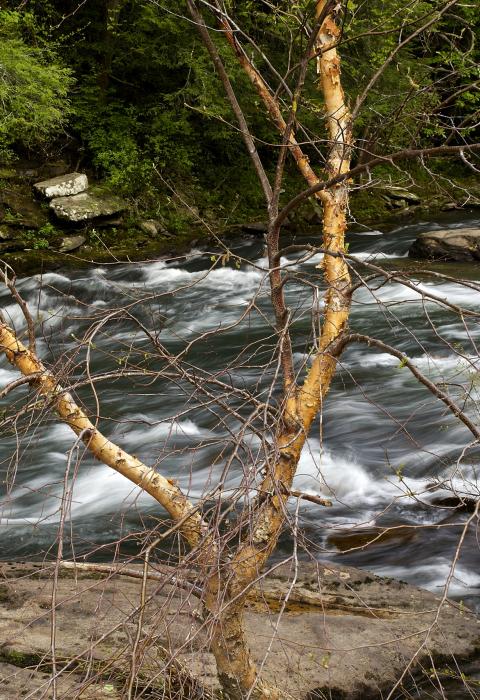Obed River
Tennessee
The Obed River system is a high-quality, rainfall-runoff-dominated watershed characterized by extremes in stream flow, both in response to seasonal rainfall variation and individual storms. The Obed River and its designated tributaries, Daddys Creek and Clear Creek, are located atop the Cumberland Plateau physiographic province in Tennessee. Wild whitewater running through 500-foot deep gorges offers boaters the chance to drift below rock climbers challenging their skills on the sandstone bluffs.
Designated Reach
October 12, 1976. The segment from the western edge of the Catoosa Wildlife Management Area to the confluence with the Emory River. Clear Creek from the Morgan County line to the confluence with the Obed River. Daddys Creek from the Morgan County line to the confluence with the Obed River. The Emory River from the confluence with the Obed River to Nemo Bridge.
Outstandingly Remarkable Values
Culture
Human occupation along the river system encompasses thousands of years of diverse cultures. The rivers provided reliable year-round water and abundant riparian resources, such as mussels, fish, birds, and mammals. People also used the rivers as important travel corridors. Prehistoric and historic use is reflected in engineering structures and archeological sites, including rock shelters, bridges, tunnels, grist mills, and home sites throughout the river system. All four segments of the Obed Wild and Scenic River system contain prehistoric rock shelter sites located at the base of the cliffs.
Ecology
The Obed River, located within one of the most species-rich temperate ecoregions in North America, protects many regionally and nationally significant habitats, several of which are riparian. The park contains 45 miles of contiguous riparian forest, some of which have never been cleared. The Obed also contains the vast majority of the globally imperiled “Cumberland river scour prairie” plant community, of which there are fewer than 500 acres remaining.
Fish
The Obed River system provides some of the most extensive and contiguous remnant habitat for the Cumberlandian aquatic species assemblage. It also represents an ecological remnant of a major free-flowing tributary to the upper Tennessee River, and it provides high-quality habitat to 52 native fish species, 8 freshwater mussels, and numerous other aquatic species. Among these are at least 5 imperiled fish species—the federally listed spotfin chub, tangerine darter, olive darter, ashy darter, and native muskellunge—the federally listed purple bean mussel, and other vulnerable species including the endemic Obed River crayfish, Emory River crayfish, and eastern hellbender.
Geology
The Obed River is located on the Cumberland Plateau Physiographic Province. The terrain is generally flat to rolling tableland, deeply dissected by steep-walled gorges. Surface geology adjacent to the wild and scenic river consists primarily of the Crab Orchard Mountain Formation, composed of conglomerate, sandstones, siltstones, shales, and coal. The rivers are geomorphically active, continually moving large amounts of sediment as they erode cliffs, slopes, and streambeds. Sediment transport is important in the creation and maintenance of the alluvial/ cobble bars found within the river channels, which support rare plant communities.
Recreation
The Obed River provides world-class climbing and regionally significant boating opportunities in the eastern United States. Its natural flows support whitewater paddling, typically from November through May. A major characteristic of both climbing and boating at the Obed is the opportunity for challenge in a highly scenic wilderness setting. Other than bridges at put-in and takeout points, paddlers can explore the park’s entire river system while encountering virtually no signs of human activity. While sport climbing is restricted to two miles of cliff within the park, traditional climbing and bouldering are allowed throughout the park.
Scenery
The Obed River cuts through the Cumberland Plateau’s sandstone cap overlaying softer shale layers, creating a canyon environment that gives visitors the impression that they are in deep wilderness. During times of medium flow, the park’s larger streams are often a brilliant turquoise, providing a dramatic contrast to the geologic features. At these times, the river dances an intricate swirling course through a labyrinth of boulders and eddies, racing through narrow chutes at a breathtaking pace, and plummeting from high ledges, tossing spray and foam high into the air.
Wildlife
The river contains exemplary habitat for five imperiled wildlife species in the southeast region. The park provides nesting and foraging habitat for one of the largest concentrations of the rare Swainson’s warbler. The abundant cliff lines provide essential roosting habitat for eastern small-footed bat populations and Rafinesque’s big-eared bat populations in close proximity to foraging habitat along the river. Both of these bat species are under consideration for federal listing. Clean, well-oxygenated waters of small tributaries to the Obed River provide optimal habitat for the Black Mountain salamander and the Cumberland dusky salamander. The Cumberland dusky salamander is endemic to the Cumberland Plateau. The Obed and its tributaries are important to the sustainability of these species, as well as to that of the river otter, which is recovering from being extirpated from the region in the late 1800s.

